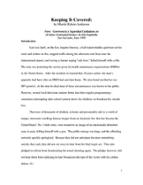Keeping It Covered
Date
Jun 1998
This conference discusses the responsibility of media when reporting on crime and the hidden purposes coverage may pursue. The interpretation of crime phenomenon by the press has become a two-edged sword for policymakers and the public. The return to democratic rule throughout the region has meant journalists can report on an endless number of topics extensively; dictatorships frequently were able to suppress the unwelcome news of social turmoil, such as crime, through censorship. However, the "cronica roja"--gripping bloodsoaked true crime tales--carried by many newspapers and magazines can and sometimes do transform individual crimes into misleading characterizations about the threats faced, and about the efficacy of the forces of order in meeting those threats. Crime news is a curious mirror of public mood, which it also helps to generate. Perceptions of threat to personal safety can influence our outlook on the rest of the world, our willingness to be open to others, and our ability to interact in ways that strengthen neighborhoods and communities. This lecture was read in the Conference: Convivencia y Seguridad Cuidadana en el Istmo Centroamericano y la Isla Española, San Salvador, El Salvador, in June of 1998.



